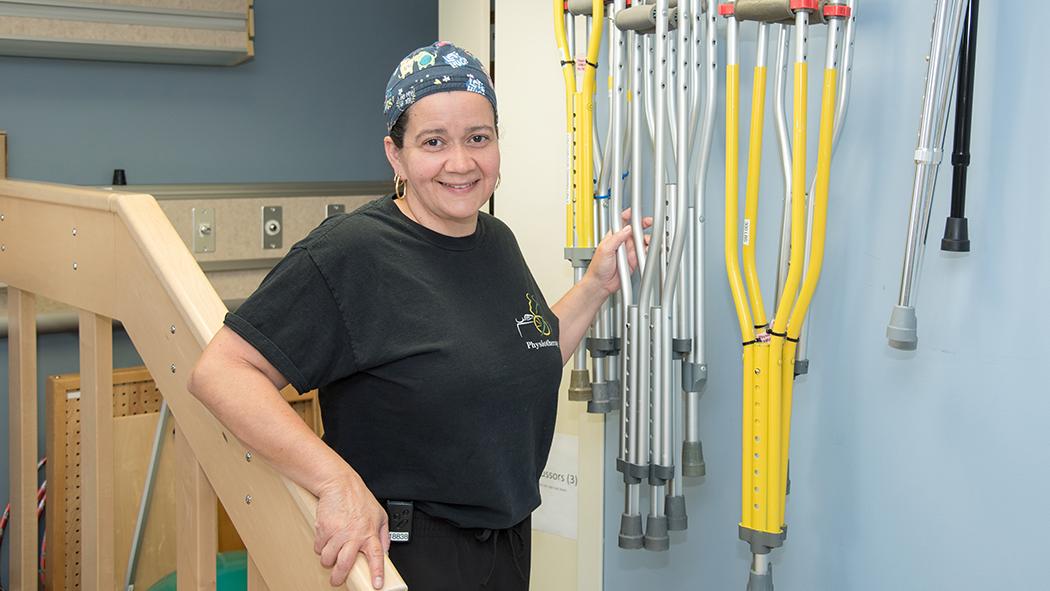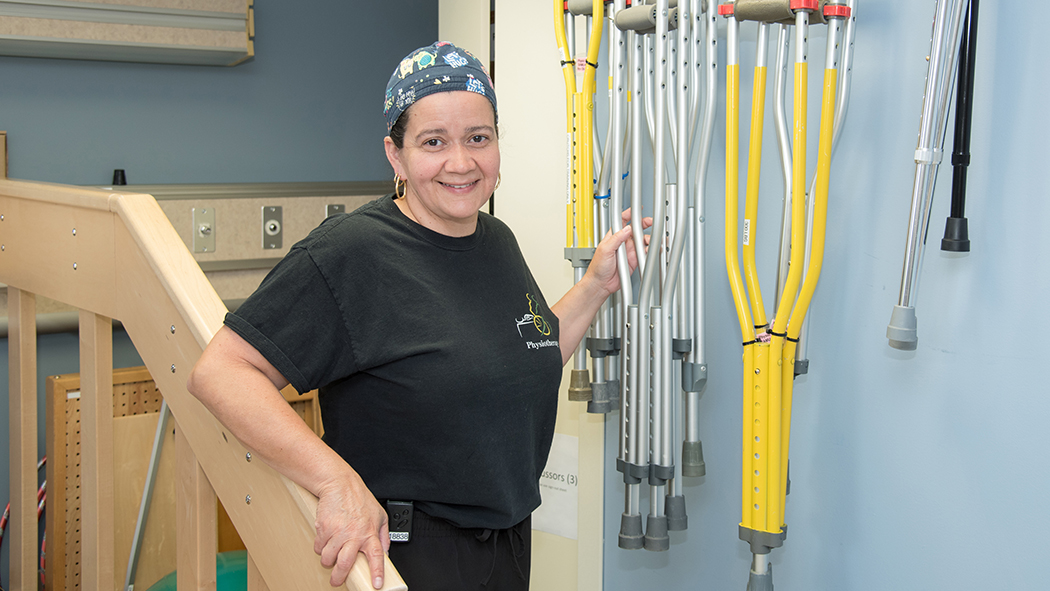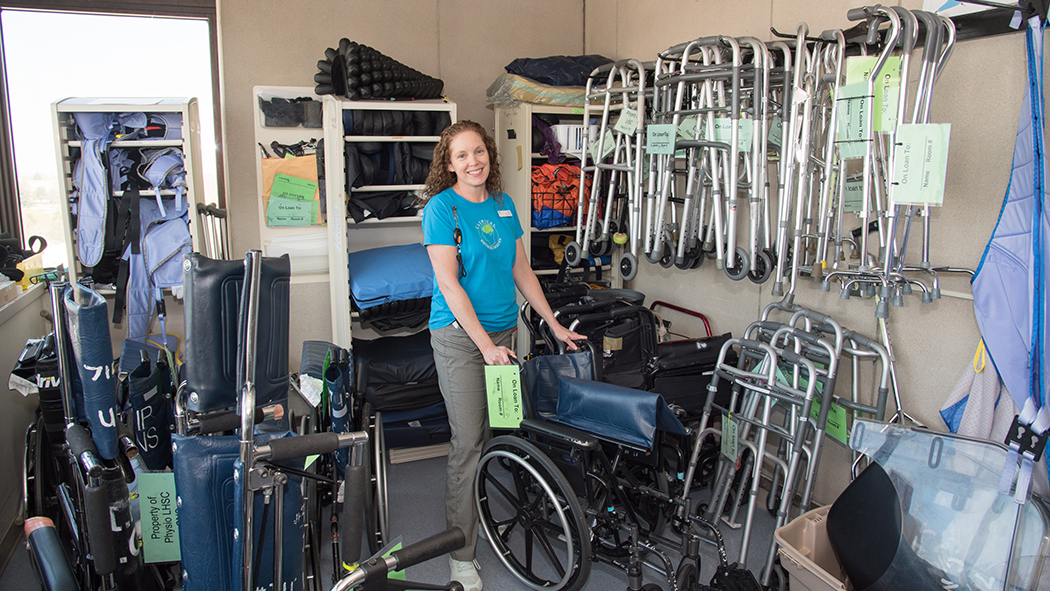
May 10, 2023
Physiotherapists (PT) and physiotherapy assistants (PTA) help patients with their mobility, and they assist patient mobility in a number of ways.
PTs and PTAs help patients regain functions such as balance, endurance and strength, to allow them to leave hospital and function well once they return home.
At London Health Sciences Centre (LHSC), there are 86 physiotherapists and 19 physiotherapy assistants with representation at both University and Victoria hospitals. There are also 12 occupational therapy/ physiotherapy assistants that support the Physiotherapy department.
Meet Megan Mayville, Physiotherapist, and Patricia Matamoros, Physiotherapy Assistant as they share more about the crucial role physiotherapists and physiotherapy assistants play in an acute care setting.
Patricia Matamoros, Physiotherapy Assistant
Patricia works as physiotherapy assistant (PTA) in the Sub Acute Medicine, Respirology, Nephrology units at LHSC.
A PTA works closely and under the supervision of a physiotherapist (PT) to help their patients increase mobility and strength so they are safe and able to go back home.
The PTA provides the physiotherapy treatments prescribed by the physiotherapist.
Following the PT instructions, the PTA performs certain exercises and gait training. Helping patients use equipment properly and safely. Documenting treatment and progress after each therapy session.
“Most of us get up every day and don’t think about our mobility,” Patricia says. “Working with patients provides new perspectives on our lives. I’m proud that I’m able to help people get up and moving again so they can regain at least some independence.”
Patricia says. “The human body is a wonder. It’s beautiful to see a patient recuperate and be able to do their activities once again.”
When working with patients one-on-one, it’s easy to develop a sense of closeness and camaraderie. Patricia shared it’s hard to see someone who has reached the limit of their ability or starts to deteriorate from the illness they have.
But when she is able to see patients, like someone who may have started in the trauma unit, bed-ridden for months, be able to sit up, then get out of bed and start walking again, those are the gratifying moments – ones where she can share in the joy of the patient’s progress.
Patricia has worked for LHSC for over 20 years and has held different roles. She began as a dialysis technician and then became a personal support worker (PSW) before she became a PTA. She has seen and helped patients in different capacities and uses her experience to inform her patient care and interactions as she helps patients regain function and mobility.
“We’re here for our patients,” Patricia says. “Our reward is seeing them achieve their goals and seeing them leave better.”
Megan Mayville, Physiotherapist
Megan works as an acute care stroke physiotherapist in Clinical Neurosciences (CNS) at LHSC. She assesses and treats stroke survivors. As part of the assessment process, Megan looks at a patient’s:
- Function
- Sensation
- Coordination
- Strength
- Balance
- Range of motion
- Their ability to breathe and clear secretions
Megan, along with all physiotherapists within LHSC, help patients with their functional recovery and help them meet their goals related to their mobility and function.
“I have my neurodevelopmental treatment certificate and use evidence-based therapy practice, stroke best practice, as well as my knowledge and experience gained over 15 years in Clinical Neurosciences to facilitate neuroplasticity and help people achieve their functional goals after a stroke,” Megan shares.
Neuroplasticity is the ability of the nervous system to reorganize its response after a stroke or traumatic brain injury. PTs in CNS help the brain to recover by following stroke best practice guidelines, alongside their knowledge and expertise. Since this patient population is in a particularly vulnerable state after their stroke, very early mobility (within the first 24 hours) is not recommended. PTs in this area also monitor the patient’s blood pressure and heart rate and do their best get their patients to a stroke rehabilitation centre in a timely manner.
“A lot of our stroke patients require two people to get them sitting and standing, so physiotherapy assistants are a critical in helping with our care,” Megan explains.
People come to hospital with a variety of illnesses and injuries and often require physiotherapy to regain function they lost. There are three main areas that physiotherapy supports:
- Orthopaedics/Musculoskeletal
- Neurology
- Cardiorespiratory
Many patient needs overlap in these categories.
For example, PTs assist patients after hip or knee surgeries (Orthopaedics/Musculoskeletal), after stroke or traumatic brain injury (neurological) or those with cardiac or respiratory concerns (e.g., shortness of breath, trouble clearing secretions). PTs use devices such as the cough assist machine and suctioning to help keep lungs clear. PTs are integral in intensive care units in keeping people off of ventilators and able to breathe on their own without support.
In all areas, PTs work as part of an interdisciplinary team that includes physiotherapy and occupational therapy assistants, speech language pathologists, social workers, dietitians, occupational therapists, nurses, PSWs, physicians, respiratory therapists, and other specialists.
“After working with a patient on their recovery for weeks or months, it is so rewarding to see someone standing or walking for the first time,” Megan says. “Patients are at the center of everything I do. And working as part of an interdisciplinary team is critical to my work. We have a strong team in Clinical Neurosciences that I’m grateful for.”
PTs perform therapy based on patient goals. PTs are mobility consultants, but aren’t the only ones who have the ability to move patients. As part of their role, they also educate staff how best to move patients with their routine mobility, such as going to the bathroom or walking down the hall, to ensure patients continue to recover and improve in their mobility.

